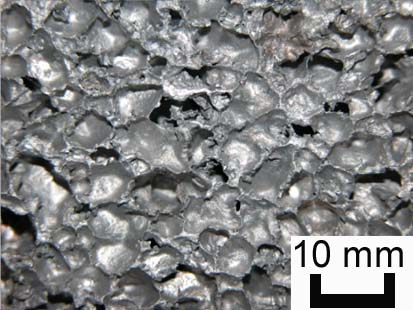|
ポーラスアルミニウムの作製および接合に関する研究 |

|
|
ポーラスアルミニウムは内部に多数の気孔を有している.軽量,断熱,衝撃吸収,制振といった多くの工業的に有益な特性を有している.ポーラスアルミニウムをコア材料とするポーラスアルミニウムコアハニカムサンドイッチ材料は軽量構造材料として有望であり,ロケットのノーズコーンに用いられている.しかしながら,素材や製造コストが高価なため,ポーラスアルミニウムは高価である.本研究室では安価にポーラスアルミニウムを作製するための研究を行っている. |
|
F.Y.2016 |
|
We carry out following experiments in order to clarify the effect of Si content ratios in a brazing precursor made of Al-Si alloy on the bonding strength by foaming bonding. The foaming test is carried out by changing alumina powder additions and heat holding time to find optimum foaming condition of the brazing precursor. The foam bonding test is carried out using brazing precursors with various Si content ratios. The bonding strength and the bonding state of foam bonding specimens are evaluated using the four-point bending test and the cross-section observation. Conclusions are as follows; (1) Optimum foaming condition of the brazing precursor can be obtained at heating time for 12 min and 3 mass% alumina powder additions. (2) Destruction and melting of cell wall of the matrix can be prevented using the brazing precursor with low Si content ratio. (3) Bonding strength decreases with decreasing the Si content ratio in brazing precursor after 20 min holding. ↑ Return to top |
|
F.Y.2015 |
|
The purpose of this study is to manufacture the aluminum foams by recycling of cheap aluminum foil chips. A precursor method is used for the manufacturing. A precursor is obtained by hot uniaxial pressing. Sintering of precursor is insufficient because of using aluminum foil chips. Equal channel angular pressing (ECAP) is making densification of the precursor. ECAP is used for consolidation of aluminum powder. Foaming tests are carried out using a cylindrical specimen cut from the precursor. Compressive tests are carried out for clarifying the availability of aluminum foams made of aluminum foil chips. Conclusions are as follows: (1) Cracking and filling rate are decreased by using the ECAP. (2) Cracking is decreased by adding Zn powder. (3) Cracking disappears by using the ECAP and adding Zn powder. Compared to a conventional method, proposed method can obtain the 43.4 % increase in maximum porosity. Aluminum foam is produced in this study and ALPORAS have equal absorption energy. ↑ Return to top |
|
F.Y.2014 |
|
Foam bonding process using low-melting-point precursor manufactured by powder metallurgical process was investigated by flexure strength, bonding state and heat influence to aluminum foam. Low-melting-point precursor was manufactured by mixing with ADC12 aluminum alloy, TiH2 and Al2O3 powder and using uniaxial hot pressing. Foam bonding was carried out by heating and foaming low-melting-point precursor between aluminum foams at temperature below melting-point of pure aluminum. In order to evaluate flexure strength, bonding state and heat influence on aluminum foam in foam bonding, foam bonding specimen was used for four-points bending test and cross-section observation and aluminum foam was used for heat test at foam bonding temperature. Flexure strength of foam bonding specimen was two-thirds of flexure strength of aluminum foam. Bonding state was not metal bonding but structural joining. Aluminum foam had little heat influence. ↑ Return to top |
|
F.Y.2013 |
|
Aluminum foil chips TiH2 powder and Al2O3 powder are mixed. A precursor is obtained by hot pressing the mixture at high temperature. ECAP with single-pass is performed on the precursor at different temperatures (573-673 K). ECAP with multi-pass is also performed on the precursor up to 4 passes at 673 K. The precursors with and without in ECAP were foamed at 983 K for 12 min. The porosity is increased with increase ECAP temperature and pass number. The densification of the precursor is promoted by ECAP at high temperature. The bonding strength between aluminum foil chips would be increased with increase in ECAP pass number. ↑ Return to top |
|
F.Y.2012(B4) |
|
Porous aluminum is one of the most promising materials in regard to environmental and energy problem and recently has been promoted in some practical applications in the field of shock absorbers and sound insulating material. However, porous aluminum is inferior dense aluminum in terms of bondability due to cell structure. We proposed method that porous aluminum bonded to each other almost no external force by using a precursor method. Conclusions are as follows : (1) Foaming bonding using the brazing precursor is possible from the observation of the section. (2) Bonded specimen by foaming brazing precursor has bending strength as half as no bonded foam. ↑ Return to top |